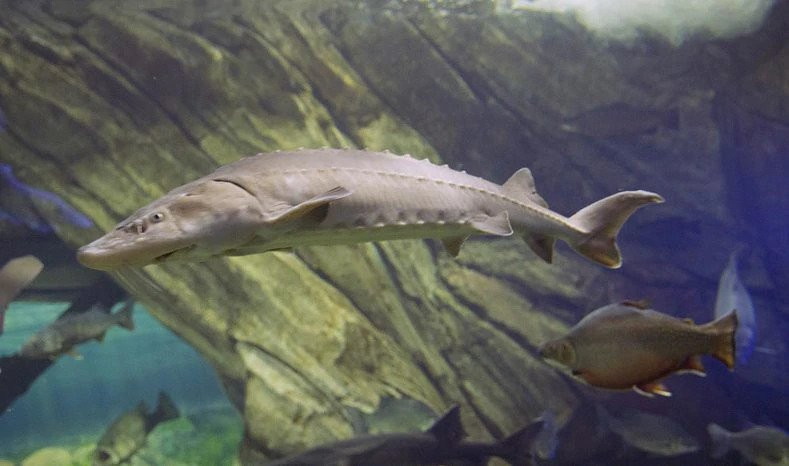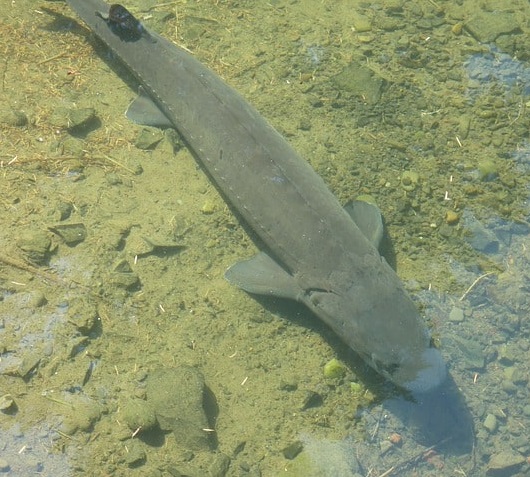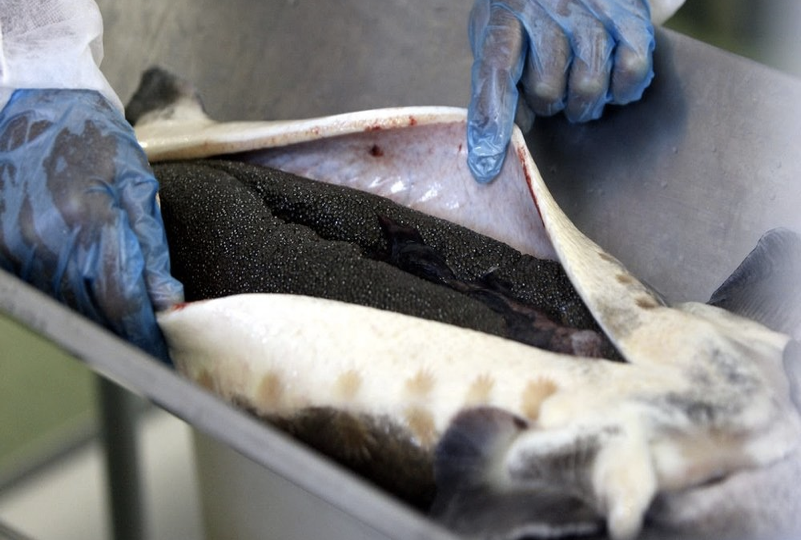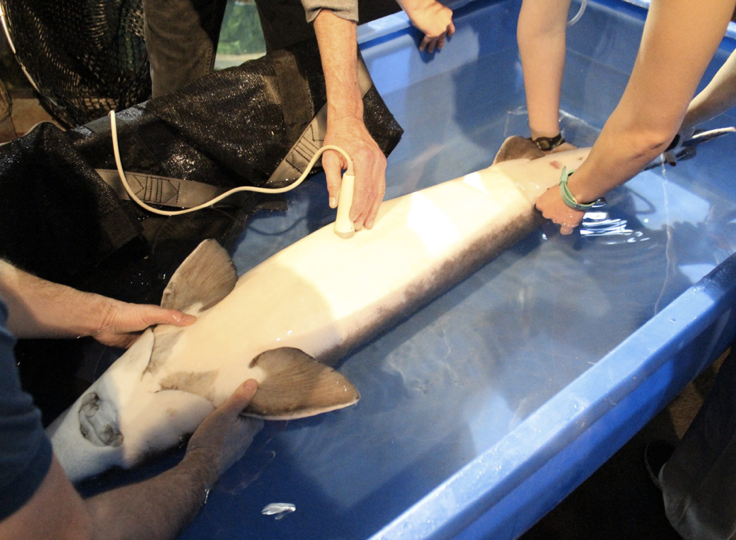Caviar Harvesting: Where Does Caviar Come From? | How is Caviar Made?

How do you make caviar?
Well, quite obviously the eggs are made by the sturgeon fish, but the farming, harvesting, and handling methods can make a huge difference in the quality of the final product.
Caviar comes from a variety of sturgeon roe, which is typically obtained through 2 caviar harvesting processes. Once the roe is harvested from the sturgeon fish, the roe sacks are rubbed across a stainless steel mesh screen to separate the eggs from the membrane. The eggs are then rinsed and inspected with tweezers to remove impurities, membrane residue, and broken eggs. Lastly, the caviar is weighed, salted, and packaged.
Caviar production is pretty straightforward once the roe is harvested, but that process is much more complex. Below we will discuss the 2 main harvesting techniques, along with which fish produce caviar.
What fish makes caviar?
In order to be true caviar, the fish roe must come from the sturgeon fish (the Acipenseridae family), but oftentimes, people consider roe extracted from other fish as caviar too. The reason for this discrepancy is because the United States allows any salted-cured fish roe to be labeled as caviar. The rest of the world defines the word “caviar” as salted-cured roe that is solely from sturgeon fish. These sturgeon fish could be, but are not limited to:

- Kaluga Sturgeon
- Russian Sturgeon
- Amur Sturgeon (Japanese Sturgeon)
- Adriatic Sturgeon
- Persian Sturgeon
- Siberian Sturgeon
- Shovelnose Sturgeon
- White Sturgeon
- Sterlet Sturgeon
- Starry Sturgeon
- And many more...
Want to learn more about the world’s 27 sturgeon and paddlefish species - some species are coveted for their eggs, others don’t make the mark.
How is caviar harvested?
Caviar harvesting is the process of extracting unfertilized fish eggs (roe) from sturgeon fish. When extracting fish roe from sturgeon, there are two main processes: the classic harvesting method and the "no-kill" harvesting method. The classic method kills the fish, while the humane method keeps the fish alive and extracts the roe through the vivace or c-section method. Below we will discuss the details of each of these processes and why/when they are used.
Are fish killed for caviar?
"Do you have to kill the fish to make caviar?" is a question we get asked a lot. While we have the same concerns our customers do regarding the well-being of caviar-producing species, the answer is usually an unfortunate "yes".
With modern advances in no-kill caviar technologies, it is possible to extract caviar without having to kill the sturgeon, but many farms still use the classic harvesting method for a very specific reason - preserving the quality and consistency of the caviar. We will address the differences between these two methods below.
The Classic Caviar Harvesting Method

For centuries, the process to obtain caviar has been nearly the same. Despite advances in farming, fishing, and production technology, the practice of harvesting fish roe has not really changed, with methods being passed down from generation to generation.
Since the decline of wild sturgeon populations, the traditional Russian and Iranian harvesting techniques still continue today, just with farmed sturgeon instead of wild, but killing the fish in order to harvest its eggs is still required to make fine caviar.
- In modern fish farms and fisheries, the adult roe-carrying fish is slowly cooled in ice-cold waters to reduce their movement, lower fat content, and help render them unconscious before being brought to harvest.
- The fish is quickly killed while unconscious, all extremities are cleaned with purified water, then an incision is made along the fish's belly to remove the roe.
- Most fish have two roe sacks. These are removed immediately as the fish is killed, otherwise, the body will release a post-mortem chemical that will harm the eggs. The egg sacks are cleaned and the remainder of the fish is set aside to be harvested for meat, skin, and useful by-products.
- Each roe sack, or skein as they are called in salmon and trout, is screened on a sieve or other mesh screen to separate the eggs from the membrane.
- These “green eggs” are washed and filtered a second time, then drained and set aside to be weighed, salt-cured, and graded.
Here is a fun video of Gordon Ramsay visiting a caviar farm in Spain, showing the process from farm to table: https://www.youtube.com/watch?v=88aDJFdUjH4
The "No-Kill" Harvesting Method
Unlike the classic method of harvesting fish roe, the newer and less-common method completes caviar extractions through "no-kill", or "cruelty" free caviar, this method usually uses hormone therapy combined with milking techniques and/or C-section-like surgery to get stabilized eggs without harming the fish.
Harvesting caviar without killing fish is not an easy process. Due to the network of cells which stabilize a fish's egg, all unfertilized mature eggs are inedible as soon as they leave the mother and enter the water, and are impossible to collect after they have been fertilized. That is the reason that immature eggs are traditionally cut from the fish before they have a chance to be delivered.
Years ago, marine biologists were able to alter fish breeding reproduction techniques to create a process by which eggs can be delivered and used to make caviar without having to kill the fish. German Scientist Angela Köhler is credited for introducing the fish-milking Köhler process to the caviar industry. Learn more about the Kohler harvesting process below.
- When an ovulating fish is nearly ready to lay their eggs, they are injected with a hormone or “signaling” protein several days prior to harvest. This helps separate the eggs from the membranous sac in the belly cavity so they can come out with ease.
- If necessary, the fish will either be cooled or sedated in some manner to prevent potential stress to the animal and damage to the product.
- The fish is washed in purified water and the eggs are removed by one of two ways:
- C-Section method: A small incision is made on the female sturgeon's belly and their eggs are carefully scooped out. After all the roe has been removed the fish is sewn back up and bandaged. This method can unfortunately leave the sturgeon vulnerable to infections and damage reproductive organs if not done with exact precision.
- Vivace method: Instead of an incision, this method utilizes a fish-milking technique, known as striping, to massage the eggs out of the fish imitating a natural delivery. To ensure that striped eggs keep their texture and do not turn into mush when harvested, they must be rinsed in a water-calcium solution immediately after being removed. This makes the green eggs strong enough to withstand further handling, salting, and curing but can be an unpleasant texture for eating.
- These green eggs are tested for firmness, then washed and filtered. After draining, the eggs are weighed, salt-cured, and graded.

No-kill caviar has been praised by conservationists for helping to increase the sustainability of certain fish, especially endangered sturgeon species. Since sturgeon can take a decade before they're old enough to develop eggs and can also live up to a century, it makes sense to try and keep these beautiful fish alive after extracting their roe. In addition to preventing the killing of a potentially endangered species, having the same female produce multiple harvests of roe can eventually cut down costs for aqua farms.
So why do most caviar producers still use the kill method?
The main problem with the non-kill method is that the classic texture and flavor of the caviar cannot be maintained. Thus not meeting the standards that caviar connoisseurs love. The C-section method causes infertility and infections in many cases, and the vivace/milking methods combination of injecting labor-inducing hormones along with the calcium bath cause the eggs to be a very firm texture that many find unpalatable.
Another problem for producers is that caviar farming is a huge upfront cost and time investment, humane methods are not upfront cost savings. The additional cost of investing in the hormones, chemicals, and equipment necessary to produce no-kill caviar has prevented it from being as affordable as classically harvested caviar. However, It could eventually save the farm money by allowing for multiple harvests from the same fish, but again, the quality of caviar just isn’t making the mark for consumers and it often leaves the sturgeon at risk of serious infection. Not to mention, certain people, such as pregnant women, should not eat caviar from a fish that has been injected with labor-inducing hormones.
So, despite the potential benefits of using the humane method, it has yet to be perfected. Most of the world's caviar is currently made by using the classic harvesting method. Thankfully, caviar farming in general is sustainable because it replaces the need for wild-caught caviar, allowing natural populations to come back. Farms are able to use a few hatchlings to breed solely for consumption and all parts of the sturgeon are utilized. Farmers also have to keep the sturgeons happy and stress-free or they can reabsorb their eggs!
Hopefully, one day soon the technology will be there to harvest caviar humanely at the same caliber of quality as classic, kill-method caviar. Until then, the best we can do is ensure we are eating caviar from sustainable farms with good reputations for sturgeon welfare.



 (888) 268-8780
(888) 268-8780